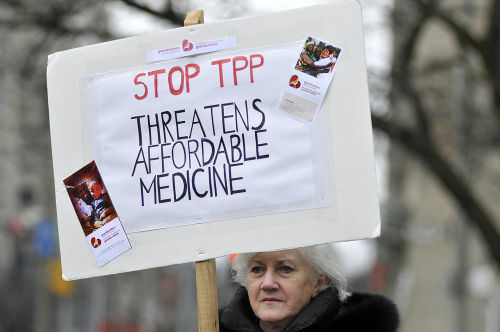O Trans-Pacific Association Agreement (TPP) established free trade between twelve countries in Asia (Japan, Brunei, Malaysia, Singapore and Vietnam), Oceania (Australia and New Zealand), North America (United States, Canada, and Mexico) and South America (Peru and Chile). The group brings together three major world powers (United States, Japan and Canada) and countries that have open, flexible and very inserted in world trade, such as some of the Asian Tigers (Malaysia and Singapore) and emerging countries in Latin America, such as Chile and the Mexico.
Due to the great economic magnitude of this agreement, it has been considered by many governments and scholars as the largest trade agreement in the world in the 21st century. The TPP can profoundly alter the development of world trade, as more than a simple trade cooperation agreement, it objective guarantee, among other items,
economic integration among member countries through the elimination or reduction of tariffs and other barriers to the circulation of goods, services and investments;
Creating common intellectual property rules of products and technologies that protect the technological innovations of member countries without compromising the scientific development of other countries;
The standardization of labor laws, thus ensuring a rise in labor standards in Asian countries to prevent the mass migration of companies attracted by cheap labor;
The development of common environmental actions that guarantee the sustainable development of the economies involved in this economic bloc;
The increase in investments internal bloc that favors the economic development of the countries and increases the economic integration between them.
As this agreement affects various sectors of the economy of the countries involved, it took nearly ten years of negotiations secrets between the member countries of the bloc to reach the document that legitimized it, signed on February 4, 2016. The concept of a bloc that would integrate the economies of the Pacific emerged in 2005 with the creation of the Trans-Pacific Strategic Economic Partnership (TPSEP) or Pacific Four (P4) for New Zealand, Chile, Singapore and Brunei.
In 2008, the United States signaled interest in starting negotiations to join the group. For this reason, the bloc achieved more international representation and four more countries joined the negotiations: Australia, Malaysia, Peru and Vietnam. In December 2011, during the Ministerial Meeting of the Apec (Economic Cooperation of Asia and the Pacific), a document with the general objectives of the agreement for systematize the negotiations until that moment, thus, two more countries joined the negotiations: Canada and Mexico. Japan, due to the lack of support for participation in the bloc, only became part of the negotiation in 2013.
Several obstacles made it difficult to approve the final document for the creation of this economic bloc, from individual interests of each country to approval of the document by the Congress of the countries involved, mainly the United States, which were divided in relation to the creation of this bloc economic. Thus, the agreement was only put into effect in 2016, establishing a free trade area and a series of adjustments and goals to implement the treaty.
As the TPP is still recent, it is too early to determine what the consequences of it to the countries involved and to world trade, as its success depends on the fulfillment of a series of measures economic, social and environmental issues that are not so simple to implement and will depend on government policies implanted. Despite this, economic prospects for member countries are quite optimistic. Together they are believed to account for 40% of the entire world economy, a third of all world exports, a consumer market of about 800 million people and will move, by 2025, about 223 billion dollars per year.
As for other countries in the world, the formation of this economic bloc is seen with some concern given the large international economic representation of its members, who currently establish relationships with several countries that do not part of the treaty. A possible consequence would be the reduction of trade relations with countries that are not part of the economic bloc, because, due to the elimination of tariffs and barriers to the circulation of goods proposed by the TPP, it will be more advantageous to do business between the countries of the wake up.
The creation of this bloc could also harm the economic recovery of European countries. This is because, with the creation of the TPP, its member countries end up strengthening relations between them and decreasing relations with other countries in the world, including European countries that depend on greater economic interaction with the United States and Southeast Asian countries to overcome the global economic crisis, which had more serious consequences in this continent. Furthermore, the TPP is seen by many scholars as a reaction to Chinese economic growth. If the TPP succeeds, it should limit China's influence in Asia and diminish the dominance of Chinese products in the global market.

Protester with poster against TPP approval that reads: "Stop TPP, threat to affordable medicines" *
The elaboration of this agreement generated several contrary manifestations, as it presents points that can directly affect the quality of life in member countries, especially developed countries such as the United States, Canada and Japan. Among the main points criticized are the agreements on patents, services provided on the internet and the standardization of labor laws, which can affect both the supply and quality of jobs and the value of salary.
Thus, although it seems highly advantageous, the TPP can negatively affect the economy of other countries and some segments of the population of the member countries themselves. To avoid being affected by this agreement, the other nations of the world must boost their economy and strengthen their economic ties among themselves, seeking multilateral economic agreements or between countries that develop some type of activity. The population of the member countries of this agreement, on the other hand, needs to pressure their respective governments to prevent the adjustments necessary for this economic integration result in a drop in the quality of life of the population or in their rights. individual.
* Image credits shutterstock.com and arindabanerjee.
By Thamires Olimpia
Graduated in Geography
Source: Brazil School - https://brasilescola.uol.com.br/geografia/acordo-associacao-transpacifico-tpp.htm

